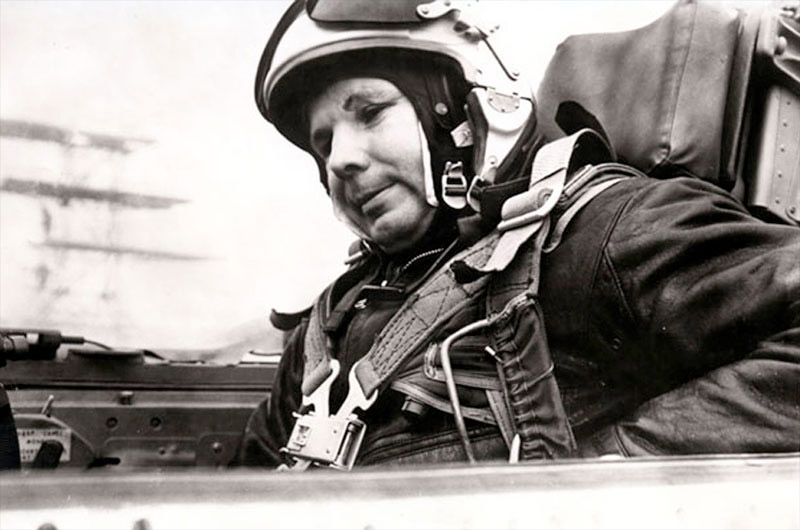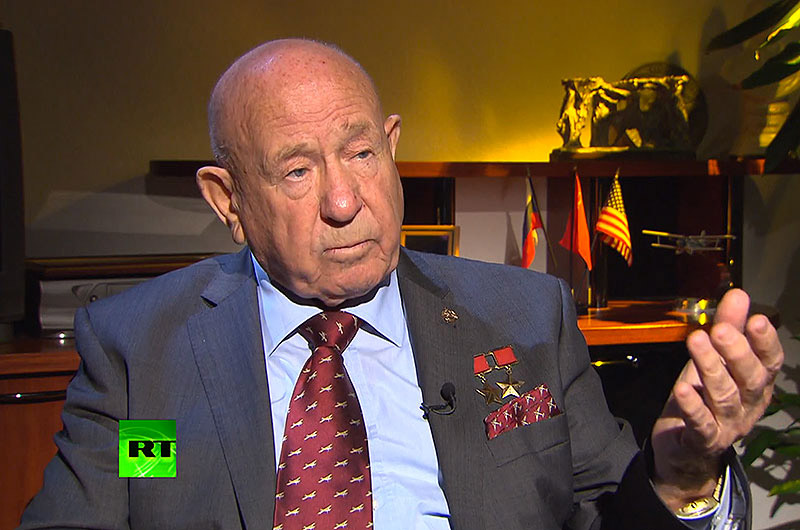Details in Death of Yuri Gagarin, 1st Man in Space, Revealed 45 Years Later

The circumstances surrounding the death of the first man in space Yuri Gagarin, who was killed in a 1968 jet crash, have long been clouded in theories and rumors. Now, the first man to walk in space says he can reveal what really happened to his friend and fellow Russian cosmonaut.
Alexei Leonov, who in 1965 became the first man to leave a spacecraft and float in the open vacuum of space, has worked for years to learn what led to Gagarin's death. He finally gained permission and spoke about the details in an interview released on Friday (June 14) by the state-funded Russia Today (RT) television network.
Yuri Gagarin made history by launching on the world's first manned spaceflight on April 12, 1961. He died just shy of his Vostok 1 mission's seventh anniversary, on March 27, 1968, when the MiG-15 fighter jet that he and instructor Vladimir Seryogin were piloting on a routine training flight went down outside a small town near Moscow. [Photo Gallery: First Man in Space — Yuri Gagarin in Pictures]
Leonov, who had been in the vicinity that day and reported hearing two loud booms in the distance, served on the state commission that investigated the crash. The official findings reported Gagarin and Seryogin had maneuvered to avoid colliding with bird or other object, and as a result, entered a tailspin and plummeted to the ground.
"That conclusion is believable to a civilian — [but] not to a professional," Leonov, now 79, explained to RT. "In fact, everything went down differently."
Vodka, vent or vertical drop
The official explanation of how Yuri Gagarin died did not go unchallenged, and not by Leonov alone. Many theories, ranging from the technical to the conspiratorial, have been raised in the decades since. [Vostok 1: Yuri Gagarin's Historic Manned Spaceflight Recalled (Video)]
Breaking space news, the latest updates on rocket launches, skywatching events and more!
The Soviet government, military and even the KGB looked into some the claims, dismissing rumors that Gagarin had been intoxicated, or that he and Seryogin had been "taking potshots at wild deer from their plane, causing it to spiral out of control," as Leonov recounted in "Two Sides of the Moon," the joint-biography he penned with U.S. astronaut David Scott in 2004.
The government's investigations also ruled out sabotage.
Documents declassified in 2003 revealed that the KGB had suspected air traffic controllers as having contributed inadvertently to the crash by providing bad weather data. Gagarin and Seryogin were led to believe that a bank of clouds were higher than they really were, leaving them too little time to recover from a spin, the intelligence agency suggested.
Yet another theory, put forth by a retired Soviet Air Force colonel, proposed that the pilot who had previously flown the MiG-15 jet had tampered with or otherwise left an air vent open in the cockpit, leading to Gagarin and Seryogin suffering from oxygen deprivation at altitude.
For his part, Leonov held for years that he thought the first loud boom he heard was another jet breaking the sound barrier, followed soon thereafter by the sound of Gagarin's jet hitting the ground.
Another pilot's error
"We knew that a Su-15 [fighter jet] was scheduled to be tested that day, but it was supposed to be flying at the altitude of 10,000 meters [33,000 feet] or higher, not 450-500 meters [1,480-1,640 feet]," Leonov told RT. "It was a violation of the flight procedure."
A new declassified report confirmed that an unauthorized Sukhoi (Su-15) supersonic jet flew dangerously close to Gagarin's MiG-15.
"While afterburning the aircraft reduced its echelon at a distance of 10-15 meters [30-50 ft] in the clouds, passing close to Gagarin, turning his plane and thus sending it into a tailspin — a deep spiral, to be precise — at a speed of 750 kilometers per hour [470 miles per hour]," Leonov said in the television interview.
Upon seeing the released report, Leonov also realized that his own account of that day had been recorded incorrectly. The report suggested that he heard the loud booms 15 to 20 seconds apart, when it was actually two seconds.
"That suggested that the two jets must have been no less than 50 kilometers apart." Leonov said.
Armed with the report's data, a new computer simulation was generated, revealing why Gagarin's jet went down.
"Now, a jet can sink into a deep spiral if a larger, heavier aircraft passes by too close and flips [the jet] over with its backwash. And that is exactly what happened to Gagarin. That trajectory was the only one that corresponded with all our input parameters," Leonov told RT.
Leonov was allowed to go public with the story, except for one detail: the Su-15 pilot's name. That pilot, who is now 80, is said to be in poor health.
"I was asked not to disclose the pilot's name," Leonov explained. "He is a good test pilot... It will fix nothing."
Follow collectSPACE.com on Facebook and on Twitter at @collectSPACE. Copyright 2013 collectSPACE.com. All rights reserved.

Robert Pearlman is a space historian, journalist and the founder and editor of collectSPACE.com, a daily news publication and community devoted to space history with a particular focus on how and where space exploration intersects with pop culture. Pearlman is also a contributing writer for Space.com and co-author of "Space Stations: The Art, Science, and Reality of Working in Space” published by Smithsonian Books in 2018.
In 2009, he was inducted into the U.S. Space Camp Hall of Fame in Huntsville, Alabama. In 2021, he was honored by the American Astronautical Society with the Ordway Award for Sustained Excellence in Spaceflight History. In 2023, the National Space Club Florida Committee recognized Pearlman with the Kolcum News and Communications Award for excellence in telling the space story along the Space Coast and throughout the world.


